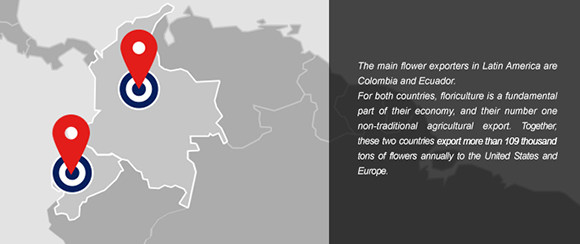Valentine’s Day, celebrated in February, is the time of year when the greatest volume of flowers are exported around the world. The most demanding period, that is, when the shipping volume is double that of the yearly average, begins around January 24 and ends February 6.
The history of Valentine’s Day dates back to the third century A.D. when Christian priest named Valentin performed marriages for young lovers persecuted by Emperor Claudius II. Believing that single men made better soldiers given their fewer emotional ties to their wives and families, Emperor Claudius II banned all new marriges and engagements in Rome. As a punishment for Valentines’s defiance of the Emperor’s decree, he was imprisoned and later put to death on Februery 14, 270. For his service, Valentine was named a saint after his death . Valentine’s Day is celebrated in honor of his death. Chocolates, and especially flowers, are the most common gifts given on this holiday.
The most popular varieties of flowers sold and shipped for Valentine’s Day are red roses (more than 60%), carnations, dahlias, and chrysanthemums.
The main flower exporters in Latin America are Colombia and Ecuador. For both countries, floriculture is a fundamental part of their economy, and their number one non-traditional agricultural export. Together, these two countries export more than 109 thousand tons of flowers annually to the United States and Europe
The flower market includes numerous players that participate at different stages of the export process. Colombia, one of the world’s largest flower producers and exporters, has about 17,000 acres cultivated in flowers. Ecuador has nearly 10,000 cultivated acres, which in any given year yield nearly 3 billion flowers.
Flowers are shipped to several distribution centers including Miami in North America, Amsterdam in Europe, and Sidney in the Oceania region, following rigorous standards to ensure continuous cold chain to preserve the product during shipment.
More than 15 million flower bouquets are transported around the world by LAN CARGO and its affiliated carriers during a 2 week period. The Boeing 777-F aircraft has enough capacity to ship approximately 6,000 boxes of roses.
Once the flowers arrive at their destination, rigorous phytosanitary inspections of samples are conducted by local authorities. If the flowers meet the phytosanitary import requirements, they are delivered to consignees who distribute them final points of sale.
The majority of the flowers exported from Colombia and Ecuador arrived to Miami, one of the world’s major distribution centers. LAN CARGO’s Miami facility at the airport is the company’s main warehouse facility within the United States. In response to growth in flower exports, LAN CARGO’s Miami cooler facility was recently expanded and re-launched for the 2013 Valentine’s Day season with capacity of nearly 30% and innovative space for the storage of up to 160 tons of goods.
By the end of the 2013 Valentine’s Day season, LAN CARGO and its affiliate companies will have shipped more than 5,700 tons of flowers in celebration of love. That amount of flowers requires more than 130 flights from Colombia and Ecuador during the Valentine’s Day season, which translates into one cargo load of flowers every 2.5 hours for 14 days straight.
